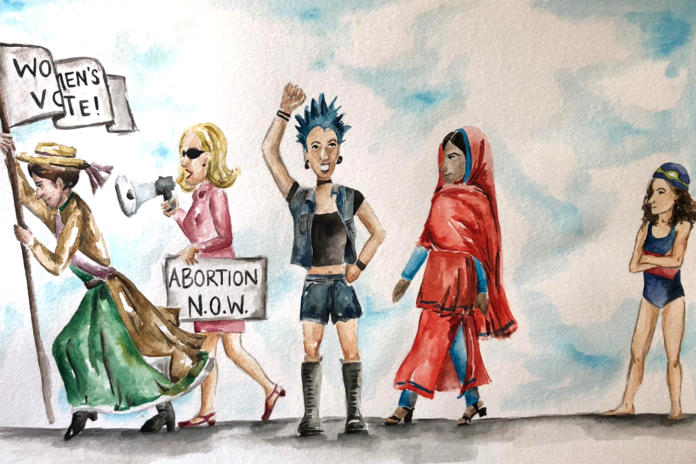Feminism, much like the tides, is ever-evolving and responds dynamically to cultural shifts and societal needs. The Third-Wave Feminist Movement arose in the latter part of the 20th century, primarily from the 1990s onward. This wave emerged as a reaction to the perceived shortcomings of Second-Wave Feminism, a movement that firmly established the groundwork for gender equality but sometimes neglected individual experiences and intersectional identities. At its core, Third-Wave Feminism advocates for inclusivity, celebrating diversity among women, and recognizing various factors such as race, class, and sexual orientation.
The fundamental question at hand—Is Third-Wave Feminism factually justified?—requires a rigorous analysis interspersed with a touch of playful skepticism. One must examine historical context, principles at the forefront of this movement, and critically assess its practical impacts on society. Let us embark on this analytical exploration.
Historical Context: Understanding the Roots of Feminist Waves
To grasp the essence of Third-Wave Feminism, it is imperative to first contextualize it within its historical lineage. The suffragettes of the early 20th century marked the dawn of First-Wave Feminism, primarily focused on legal issues and inequalities, particularly regarding suffrage rights. The Second-Wave, gaining momentum in the 1960s and 70s, broadened its scope to address workplace discrimination, reproductive rights, and sexual liberation. However, the deficiencies inherent in these movements became starkly apparent. Not all women had the privilege to share a universal experience; class, race, and sexuality created fractures within feminist discourse.
This realization led to a proliferation of feminist voices in the Third-Wave, where diverse experiences began to shape the narrative. The rise of individualism in the late 20th century, concurrent with a burgeoning engagement with postmodern thought, encouraged a reevaluation of what it meant to be a feminist. Critics of Second-Wave ideology, such as Rebecca Walker, have emphasized the importance of acknowledging the complexity of women’s identities. Therefore, the historical premise rooted in the experiences of a monolithic “woman” needed transformation.
Embracing Intersectionality: The Philosophy of Inclusion
The pivotal concept of intersectionality emerged prominently during this wave of feminism. Coined by legal scholar Kimberlé Crenshaw, intersectionality elucidated how various forms of oppression interconnect and compound individual experiences. No longer was feminism a one-size-fits-all model; it became an expansive framework that charted the intricacies of race, class, and sexual orientation influencing gender issues. This evolution was not merely theoretical—Third-Wave Feminism made a concerted effort to centrate marginalized voices.
Examining the advocacy efforts and artistic expressions driven by Third-Wave feminists reveals an intentional inclusivity. From the celebration of women of color to the inclusion of LGBTQ+ rights within feminist movements, the shift reflects broader societal changes. It ignited a conversation about privilege, challenging the conventional narratives dictated by predominantly white, middle-class feminists of earlier waves. Notably, the establishment of various grassroots organizations emerged, such as the “Third Wave Foundation,” aiming to empower young feminists and activists. Such efforts underscore a foundational justification for Third-Wave Feminism, presenting a moral imperative for representation.
Challenging Patriarchal Norms: The Disruption of Gender Identity
One cannot discuss Third-Wave Feminism without acknowledging its audacious stance towards reconstructing gender identity. The movement opened the floodgates to a broad spectrum of interpretations surrounding gender. Rejecting the binary view of gender as male and female, Third-Wave feminists, buoyed by queer theory and gender studies, began to articulate the idea that gender is not merely a biological construct but rather a social performance influenced by cultural expectations.
This ideological shift manifestly challenges patriarchal hegemony. By embracing non-binary identities and advocating for fluidity, Third-Wave Feminism made a significant impact in academic and social discourse. The incorporation of feminist perspectives in contemporary discussions regarding gender identity can be seen in educational institutions and media representations, illustrating a tangible impact of the movement. Yet, while the philosophical bases may appear robust, it is essential to interrogate whether these concepts translate into actionable change. Are societal perceptions truly evolving, or does the advocacy for fluid identities merely reinforce existing stereotypes under a new guise?
The Impacts: Social Movements and the Digital Age
As Third-Wave Feminism burgeoned in the virtual sphere, it deftly navigated new avenues for activism. The advent of the internet catalyzed unprecedented access to feminist discourse. Social media became an arena where feminist voices could mobilize widespread grassroots campaigns, amplifying issues like sexual harassment and assault—most notably seen in the #MeToo movement. The online world thus transformed the landscape of activism, invigorating the feminist discourse with immediacy and relevance.
However, the digital age also poses challenges. The democratization of information can result in misinformation and an oversimplification of complex feminist issues. Can the carefully nuanced arguments of Third-Wave Feminism withstand the rapid-fire scrutiny of social media? As we ponder these questions, it becomes clear that while the movement’s inclusivity and adaptability merit acknowledgment, it must also contend with the fragmented narratives emerging from digital interactions.
Concluding Reflections: Towards a Nuanced Feminist Future
In scrutinizing the legitimacy of Third-Wave Feminism, one arrives at a kaleidoscope of perspectives. The wave is indubitably factually justified when examined through the lens of intersectionality, the challenge to patriarchal norms, and the lasting impact on contemporary social movements. Nevertheless, it is also essential to remain aware of the complexities and potential pitfalls arising from its digital manifestation. The proliferation of voices can lead to discord and splintering within the feminist community, sometimes overshadowing the original intent of inclusivity.
Ultimately, as society continues to grapple with gender issues and as new questions arise, one must ponder: how can Third-Wave Feminism adapt to address evolving realities? The answer may lie not only in maintaining its foundational principles but also in fostering dialogue, patience, and collaboration across diverse feminist spectra. Challenge yourself to engage with these complexities and recognize the tapestry of experiences that continue to inform and enrich the ongoing struggle for gender equality.





























